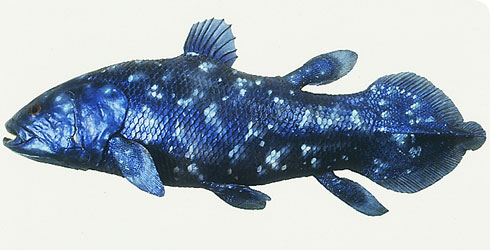Biology and behaviour
Molecular biology
The mitochondrial genome is known for both coelacanth species, showing an overall difference of only 4.28 percent (Inoue et al, Gene 349: 227–235).
Reproduction
Coelacanth reproduction was thought to be strictly oviparous, as large eggs had been discovered in female specimens. However, in 1975, researchers at the American Museum of Natural History in New York dissected a female Latimeria in their collection, finding 5 coelacanth pups. This indicates Laterimeria chalumna produced eggs that were internally fertilised and held within the female until the pups were ready to be born. This style of reproduction is known as ovoviviparous.
Behaviour
Laterimeria chalumna lives in groups in underwater caves, at depths of over 100m. It leaves the caves at night to hunt for food.
